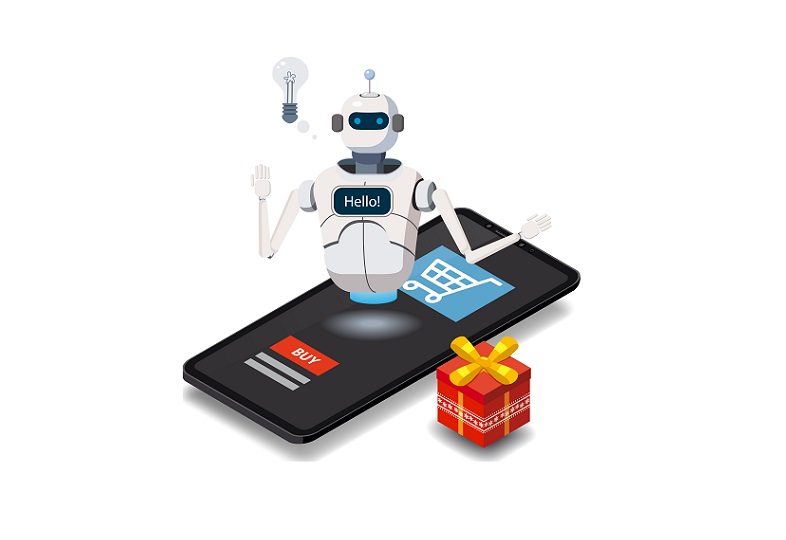The implementation of AI in ecommerce should come as no surprise. Online businesses have always been quick to adopt new technologies, and this is how the industry thrives; enhancing the customer experience, discovering new markets, and driving further sales. And with the continued development of AI technology like chatbots, visual search, and personalized recommendations, the world of ecommerce is transforming again.
But just how effective and useful is AI-powered tech? Where is it being used? And what options best suit your particular ecommerce project?
In this article, we’ll look at the most popular implementations of AI in ecommerce to determine what they do, how they are being used, and first steps for practical application. We hope it provides a good overview for thinking about and planning your own AI-based strategies.

1. Chatbots:
For a time, chatbots were set to revolutionize the ecommerce experience. However, that revolution… still has yet to fully arrive. Turns out traditional search and browsing methods are still go-to methods for online shopping. That said, chatbots do have a place in ecommerce, and are a valid way to reach customers. Shopify offers a shopping experience through Messenger that can be tailored for chatbot application. Similarly, Kik is home to a number of ecommerce chatbots by brands including H&M.
Whether you implement an AI chatbot comes down to one key point: what percentage of your customer base uses and is comfortable with messaging for purchases. This will determine if a chatbot is a good investment. This is important, because chatbots require training data in order to be effective and to, above all else, not annoy or dissuade the potential customers using them.
Chatbot training data consists of the words, sentences, questions and answers necessary for understanding and responding to queries and comments. This can come from transcriptions of recorded customer calls, email correspondence, open-source datasets, or it can be created from scratch. Your training data is the core of your chatbot’s ability to understand customer queries and reply with the appropriate answers, information, and recommendations.
Chatbot implementation takes planning and time, but the end result is customers getting what they want through a smooth, automated experience. This alone makes it a space worth researching.
Read more about building and developing chatbot training data for AI ecommerce here.

2. Visual Search Engines:
Much like chatbots, the early 2010’s came with bold predictions of the rapid rise of visual search engines for AI in ecommerce. Like that t-shirt? Take a picture of it and let an AI program find it for you and offer similar apparel. Cool idea, but where’s visual search now?
The biggest visual search success is likely Pinterest Lens. Pinterest reports that its Lens function – which offers suggestions to users based on the pictures they take – is able to identify more than 2.5 billion objects across home and fashion images. It also boasts that 80% of Lens users start with visual search when shopping. Outside of Pinterest, tech giants Facebook, Instagram, Google, and Amazon have all been making tentative moves into the field of visual search. Though it’s too early to say whether this signals a tide change, it does point to expanding variety in how we search and buy online.
Entering the visual search arena requires image annotation. This means tagging items in images based on what they are, brand names, and so on. Fashion and furniture are the most popular searches now, but food and recipes are also growing in popularity. Though it’s possible to train a machine learning model to automatically tag items as you upload them, another option is to simply outsource the tagging work to a professional annotation company, who can annotate images based on your specifications.

3. Voice Search:
Voice search is all about convenience. It’s for when you’re washing the dishes or driving to work and you can’t type “headphones under $100”. In these moments, many have the option of simply asking Siri or Alexa: “What are the best headphones under $100?”
With the proliferation of virtual assistants, this area of search is seeing steady growth. Some sources report that as much as 20% of mobile searches are done this way. This might mean that 20% of your potential customer base can’t find your service through their preferred channels. If your ecommerce business is one where people can use or benefit from voice search, it’s time to optimize. Here’s 3 ways to improve your voice search visibility:
- Customers who use voice search are usually on the go. Perhaps they’re walking from one place to another. Perhaps they’re driving. Whatever the case, voice search users want their answers quickly. Optimizing your site for speed will help potential customers get what they want, when they want it.
- Type-based search is keyword focused, but voice search is more conversational. A keyword search might simply be “Fender guitars New York” but a voice search is more likely to be along the lines of “Where can I buy Fender guitars in New York?” Putting a focus on long-tail keywords will help put you in front of potential voice search customers.
- As the above hints towards, voice searches are more conversational than type-based searches. For this reason, it’s worth targeting answers to question-type searches. Think in terms of answering questions that start with the words where, when, how, what, and who. This will help you optimize your focus for customers at all levels of the conversion funnel.
Preparing a strategy for a new search style can be daunting and time consuming. If you’re unsure about your current search strategy, it’s worth considering professional search evaluation assistance. This support can help you revise and improve your search queries, search results, related results, captions, and ads.
4. Search Improvement
A good search engine algorithm doesn’t just help customers find what they want, it also helps them find what they didn’t know they wanted. By analyzing your customer’s search queries, an optimized search algorithm can recommend customers competitive alternatives and offer complementary purchase options. Amazon is a perfect example; even when you can’t find what you want, you’ll always be offered the next best thing.
One way to implement search improvement for an ecommerce retail store is with AI product categorization. This starts broad (books, furniture, electronics) and goes very deep (book genres, furniture types, electronic brand names, etc.). A deep web of product categorization means a variety of relevant products will surface in response to a single customer query, improving their overall experience and increasing the likelihood of a purchase.
For growing businesses, manual categorization is time consuming. This is particularly true of sites with a constantly updating product range. Machine learning models can take care of this by automating the categorization process. Together with a comprehensive analytics system, an AI system can learn to categorize your products for you, and uncover new search queries and complementary item combinations.
For more on product categorization and data tagging for personalized search, start here.

5. Opinion Monitoring with Sentiment Analysis:
Modern businesses generate massive amounts of data, and this data is hugely valuable. Reviews, social media, blogs; people talk about what they use all the time, in a variety of ways. By analyzing these opinions, you get a better understanding of how people feel and talk about your company and service. This process also helps discover trends and uncover insights. There’s a lot to be learned by knowing who is talking about your product and how they’re talking about it. It can help you make important decisions about how to talk about your brand and where to focus your efforts.
However, collecting and organizing data for opinion monitoring requires time and manpower. Small start-up ventures can quickly find themselves unable to keep up as their business scales and manual data analytics requires the work of a dedicated team.
So how can AI and machine learning help?
A machine learning opinion monitoring strategy starts with data collection, pulled from in-house sources or from online. This data is cleaned, annotated for its specific purpose, then used to train the model which automates the analysis. Sentiment analysis, keyword extraction, named entity recognition; this and more can be handled automatically in real-time, freeing your team up to make decisions with data instead of struggling just to make sense of it.
The best applications of AI in ecommerce enhance the customer experience. They make the process simpler, smoother, and more convenient. This in turn encourages customers to buy. That said, any application of AI in ecommerce is a complicated endeavor, and requires planning, training, and preparation. It’s important to know what’s involved.
Fortunately, you don’t have to do it alone. If you are considering AI in ecommerce solutions, Lionbridge can help. Our dedicated team of project managers can help you analyze your ecommerce venture and help you plan AI and machine learning solutions. Our community of 1,000,000+ workers can then help you collect and annotate the data that will train and power the machine learning models that will transform your business.
This article is republished from hackernoon.






